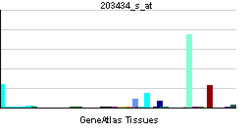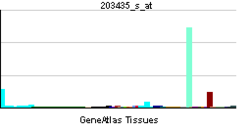- Neprilysin
-
Neprilysin, also known as membrane metallo-endopeptidase, neutral endopeptidase (NEP), CD10, and common acute lymphoblastic leukemia antigen (CALLA), is a zinc-dependent metalloprotease enzyme that degrades a number of small secreted peptides, most notably the amyloid beta peptide whose abnormal misfolding and aggregation in neural tissue has been implicated as a cause of Alzheimer's disease. Synthesized as a membrane-bound protein, the neprilysin ectodomain is released into the extracellular domain after it has been transported from the Golgi apparatus to the cell surface. In neurons, neprilysin is regulated by the protein nicastrin, a component of the gamma secretase complex that performs a necessary step in processing amyloid precursor protein to amyloid beta.[1]
Contents
Amyloid beta regulation
Mutations in the neprilysin gene have been associated with familial forms of Alzheimer's disease,[2] and neprilysin-deficient knockout mice show both Alzheimer's-like behavioral impairment and amyloid-beta deposition in the brain,[3] providing strong evidence for the protein's association with the Alzheimer's disease process. Because neprilysin is thought to be the rate-limiting step in amyloid beta degradation,[4] it has been considered a potential therapeutic target; compounds such as the peptide hormone somatostatin have been identified that increase the enzyme's activity level.[5] One hypothesis for the strong dependence of Alzheimer's incidence on age focuses on the declining production of somatostatin in the brains of elderly people, which thus depresses the activity of neprilysin and promotes aggregation of unprocessed amyloid beta.[6] Declining neprilysin activity with increasing age may also be explained by oxidative damage, known to be a causative factor in Alzheimer's disease; higher levels of inappropriately oxidized neprilysin have been found in Alzheimer's patients compared to cognitively normal elderly people.[7]
Signaling peptides
 Neprilysin immunohistochemical staining of normal kidney.
Neprilysin immunohistochemical staining of normal kidney.
Neprilysin is also associated with other biochemical processes, and is particularly highly expressed in kidney and lung tissues. Inhibitors have been designed with the aim of developing analgesic and antihypertensive agents that act by preventing neprilysin's activity against signaling peptides such as enkephalins, substance P, endothelin, and atrial natriuretic factor.[8][9]
Associations have been observed between neprilysin expression and various types of cancer; however, the relationship between neprilysin expression and carcinogenesis remains obscure. In cancer biomarker studies, the neprilysin gene is often referred to as CD10 or CALLA. In some types of cancer, such as metastatic carcinoma and some advanced melanomas, neprilysin is overexpressed;[10] in other types, most notably lung cancers, neprilysin is downregulated, and thus unable to modulate the pro-growth autocrine signaling of cancer cells via secreted peptides such as mammalian homologs related to bombesin.[11] Some plant extracts extracts (methanol extracts of Ceropegia rupicola, Kniphofia sumarae, Plectranthus cf barbatus, and an aqueous extract of Pavetta longiflora) were found able to inhibit the enzymatic activity of neutral endopeptidase.[12]
Inhibitors
- Omapatrilat
- RB-101
- UK-414,495
References
- ^ Pardossi-Piquard, R.; Dunys J., Yu G., St George-Hyslop P., Alves da Costa C. and Checler F. (May 2006). "Neprilysin activity and expression are controlled by nicastrin". Journal of Neurochemistry 97 (4): 1052–6. doi:10.1111/j.1471-4159.2006.03822.x. PMID 16606360.
- ^ Helisalmi, S; M. Hiltunen, S. Vepsäläinen, S. Iivonen, A. Mannermaa, M. Lehtovirta, A. M. Koivisto, I. Alafuzoff and H. Soininen (2004). "Polymorphisms in neprilysin gene affect the risk of Alzheimer's disease in Finnish patients". Journal of Neurology Neurosurgery and Psychiatry 75 (12): 1746–8. doi:10.1136/jnnp.2004.036574. PMC 1738829. PMID 15548496. http://jnnp.bmj.com/cgi/content/full/75/12/1746. Retrieved 2007-03-11.
- ^ Madan, Rime; Raphael Poirier, David P. Wolfer, Hans Welzl, Peter Groscurth, Hans-Peter Lipp, Bao Lu, Mohammed El Mouedden, Marc Mercken, Roger M. Nitsch and M. Hasan Mohajeri (December 2006). "Lack of neprilysin suffices to generate murine amyloid-like deposits in the brain and behavioral deficit in vivo". Journal of Neuroscience Research 84 (8): 1871–8. doi:10.1002/jnr.21074. PMID 16998901.
- ^ Iwata, Nobuhisa; Satoshi Tsubuki, Yoshie Takaki, Kaori Watanabe, Misaki Sekiguchi, Emi Hosoki, Maho Kawashima-Morishima, Hahn-Jun Lee, Emi Hama, Yoko Sekine-Aizawa and Takaomi C. Saido (February 2000). "Identification of the major Abeta1-42-degrading catabolic pathway in brain parenchyma: suppression leads to biochemical and pathological deposition". Nature Medicine 6 (2): 143–50. doi:10.1038/72237. PMID 10655101.
- ^ Iwata, Nobuhisa; Makoto Higuchi and Takaomi C. Saido (November 2005). "Metabolism of amyloid-beta peptide and Alzheimer's disease". Pharmacology & Therapeutics 108 (2): 129–48. doi:10.1016/j.pharmthera.2005.03.010. PMID 16112736.
- ^ Hama, Emi; Takaomi C. Saido (2005). "Etiology of sporadic Alzheimer's disease: somatostatin, neprilysin, and amyloid beta peptide". Medical Hypotheses 65 (3): 498–500. doi:10.1016/j.mehy.2005.02.045. PMID 15921860.
- ^ Wang, Deng-Shun; Nobuhisa Iwata, Emi Hama, Takaomi C. Saido and Dennis W. Dickson (October 2003). "Oxidized neprilysin in aging and Alzheimer's disease brains". Biochemical and Biophysical Research Communications 310 (1): 236–41. doi:10.1016/j.bbrc.2003.09.003. PMID 14511676.
- ^ Sahli, Stefan; Bernhard Stump, Tobias Welti, W. Bernd Schweizer, François Diederich, Denise Blum-Kaelin, Johannes D. Aebi and Hans-Joachim Böhm (April 2005). "A New Class of Inhibitors for the Metalloprotease Neprilysin Based on a Central Imidazole Scaffold". Helvetica Chimica Acta 88 (4): 707–730. doi:10.1002/hlca.200590050.
- ^ Oefner, C.; B. P. Roques, M.-C. Fournie-Zaluski and G. E. Dale (February 2004). "Structural analysis of neprilysin with various specific and potent inhibitors". Acta Crystallographica D 60 (Pt 2): 392–396. doi:10.1107/S0907444903027410. PMID 14747736.
- ^ Velasquez, Elsa F.; Molly Yancovitz, Anna Pavlick, Russell Berman, Richard Shapiro, Dusan Bogunovic, David O'Neill, Yi-Lo Yu, Joanna Spira, Paul J Christos, Xi Kathy Zhou, Madhu Mazumdar4, David M Nanus, Leonard Liebes, Nina Bhardwaj, David Polsky and Iman Osman (January 2007). "Clinical relevance of Neutral Endopeptidase (NEP/CD10) in melanoma". Journal of Translational Medicine 5 (2): 2. doi:10.1186/1479-5876-5-2. PMC 1770905. PMID 17207277. http://www.pubmedcentral.nih.gov/articlerender.fcgi?tool=pmcentrez&artid=1770905.
- ^ Cohen, Andrea J.; Paul A. Bunn, Wilbur Franklin, Catherine Magill-Solc, Christa Hartmann, Barbara Heifrich, Laura Gilman, Joy Folkvord, Karen Helm, and York E. Miller (15 February 1996). "Neutral endopeptidase: variable expression in human lung, inactivation in lung cancer, and modulation of peptide-induced calcium flux". Cancer Research 56 (4): 831–9. PMID 8631021. http://cancerres.aacrjournals.org/cgi/reprint/56/4/831. Retrieved 2006-03-11.
- ^ Alasbahi R, Melzig MF.,"Screening of some Yemeni medicinal plants for inhibitory activity against peptidases." Pharmazie. 2008 Jan;63(1):86-8
External links
- The MEROPS online database for peptidases and their inhibitors: M13.001
- MeSH Neprilysin
1-50 CD1 (a-c, 1A, 1D, 1E) · CD2 · CD3 (γ, δ, ε) · CD4 · CD5 · CD6 · CD7 · CD8 (a) · CD9 · CD10 · CD11 (a, b, c) · CD13 · CD14 · CD15 · CD16 (A, B) · CD18 · CD19 · CD20 · CD21 · CD22 · CD23 · CD24 · CD25 · CD26 · CD27 · CD28 · CD29 · CD30 · CD31 · CD32 (A, B) · CD33 · CD34 · CD35 · CD36 · CD37 · CD38 · CD39 · CD40 · CD41 · CD42 (a, b, c, d) · CD43 · CD44 · CD45 · CD46 · CD47 · CD48 · CD49 (a, b, c, d, e, f) · CD5051-100 CD51 · CD52 · CD53 · CD54 · CD55 · CD56 · CD57 · CD58 · CD59 · CD61 · CD62 (E, L, P) · CD63 · CD64 (A, B, C) · CD66 (a, b, c, d, e, f) · CD68 · CD69 · CD70 · CD71 · CD72 · CD73 · CD74 · CD78 · CD79 (a, b) · CD80 · CD81 · CD82 · CD83 · CD84 · CD85 (a, d, e, h, j, k) · CD86 · CD87 · CD88 · CD89 · CD90 · CD91- CD92 · CD93 · CD94 · CD95 · CD96 · CD97 · CD98 · CD99 · CD100101-150 CD101 · CD102 · CD103 · CD104 · CD105 · CD106 · CD107 (a, b) · CD108 · CD109 · CD110 · CD111 · CD112 · CD113 · CD114 · CD115 · CD116 · CD117 · CD118 · CD119 · CD120 (a, b) · CD121 (a, b) · CD122 · CD123 · CD124 · CD125 · CD126 · CD127 · CD129 · CD130 · CD131 · CD132 · CD133 · CD134 · CD135 · CD136 · CD137 · CD138 · CD140b · CD141 · CD142 · CD143 · CD144 · CD146 · CD147 · CD148 · CD150151-200 CD151 · CD152 · CD153 · CD154 · CD155 · CD156 (a, b, c) · CD157 · CD158 (a, d, e, i, k) · CD159 (a, c) · CD160 · CD161 · CD162 · CD163 · CD164 · CD166 · CD167 (a, b) · CD168 · CD169 · CD170 · CD171 · CD172 (a, b, g) · CD174 · CD177 · CD178 · CD179 (a, b) · CD181 · CD182 · CD183 · CD184 · CD185 · CD186 · CD191 · CD192 · CD193 · CD194 · CD195 · CD196 · CD197 · CDw198 · CDw199 · CD200201-250 CD201 · CD202b · CD204 · CD205 · CD206 · CD207 · CD208 · CD209 · CDw210 (a, b) · CD212 · CD213a (1, 2) · CD217 · CD218 (a, b) · CD220 · CD221 · CD222 · CD223 · CD224 · CD225 · CD226 · CD227 · CD228 · CD229 · CD230 · CD233 · CD234 · CD235 (a, b) · CD236 · CD238 · CD239 · CD240CE · CD240D · CD241 · CD243 · CD244 · CD246 · CD247- CD248 · CD249251-300 CD252 · CD253 · CD254 · CD256 · CD257 · CD258 · CD261 · CD262 · CD264 · CD265 · CD266 · CD267 · CD268 · CD269 · CD271 · CD272 · CD273 · CD274 · CD275 · CD276 · CD278 · CD279 · CD280 · CD281 · CD282 · CD283 · CD284 · CD286 · CD288 · CD289 · CD290 · CD292 · CDw293 · CD294 · CD295 · CD297 · CD298 · CD299301-350 ADAM proteins Matrix metalloproteinases Other Lymphoid Pre-B cell: CD10/CALLA · CD79A
mature: CD19 · CD20 · CD21/CR2 · CD23/FcεRII · CD127 · CD40
plasma cell: CD38 · CD138T/NKNK cellAllAllMyeloid CFU-GM/
MyelomonocyteCFU-MegCFU-ECD36 · CD71All (pan-myeloid)Stem cell Tumor markers Blood NeprilysinLymphosarcomaEndocrine Nervous system Cardiovascular/
respiratoryDigestive Reproductive/
urinary/
breastSurface epithelial-stromal tumor (CA-125) · EC (CD30, hCG) · EST (Alpha-fetoprotein) · Choriocarcinoma (hCG) · Dysgerminoma (LDH) · Sertoli-Leydig cell tumour (Testosterone) · GCT (Inhibin)General histology Musculoskeletal M: NEO
tsoc, mrkr
tumr, epon, para
drug (L1i/1e/V03)
PDB gallery 1dmt: STRUCTURE OF HUMAN NEUTRAL ENDOPEPTIDASE COMPLEXED WITH PHOSPHORAMIDON1r1h: STRUCTURAL ANALYSIS OF NEPRILYSIN WITH VARIOUS SPECIFIC AND POTENT INHIBITORS1r1i: STRUCTURAL ANALYSIS OF NEPRILYSIN WITH VARIOUS SPECIFIC AND POTENT INHIBITORS1r1j: STRUCTURAL ANALYSIS OF NEPRILYSIN WITH VARIOUS SPECIFIC AND POTENT INHIBITORS1y8j: Crystal Structure of human NEP complexed with an imidazo[4,5-c]pyridine inhibitorCategories:- Human proteins
- Alzheimer's disease
- EC 3.4.24
Wikimedia Foundation. 2010.








